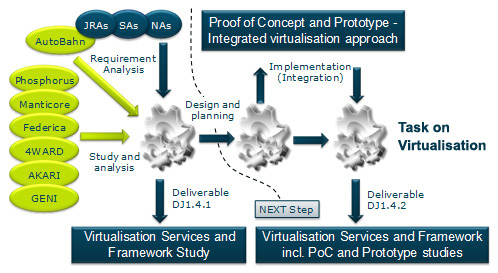Current and Potential Uses of Virtualisation
In the context of network and computing infrastructure, virtualisation is the creation of a virtual version of a physical resource (e.g. network, router, switch, optical device or computing server), based on an abstract model of that resource and often achieved by partitioning (slicing) and/or aggregation. A virtual infrastructure is a set of virtual resources interconnected together and managed by a single administrative entity.
Focus of research:
- Investigating potential uses, benefits, disadvantages and risks of infrastructure virtualisation services for the GÉANT and NREN communities compared to traditional operation.
- Analysing and assessing existing major activities, research projects and technologies that address infrastructure virtualisation.
- Investigating NRENs’ requirements for using infrastructure virtualisation technologies in the near future.
- Defining a multi-layer, multi-domain and multi-technology virtualisation architecture.
- Proposing a generic, technology-agnostic solution for integrating and interworking existing virtualisation mechanisms and solutions at different layers, leaving the choice of suitable virtualisation technologies to individual NRENs, while enabling them to offer multi-domain, multi-layer and multi-technology virtualisation services.
- Developing a fully-featured test and demonstration virtualisation mechanism capable of supporting multi-domain, multi-layer, multi-vendor and multi-technology.
- In collaboration with the Task on Federated Network Architectures, defining an infrastructure slicing architecture, tools and mechanism for virtualisation.

Results
- The results of the investigation into virtualisation have been documented in Deliverable DJ1.4.1: Virtualisation Services and Framework Study
- The Task has drafted a multi-layer, multi-domain and multi-technology virtualisation architecture for the GÉANT virtualisation service GENUS.
|


